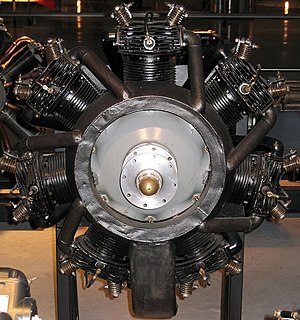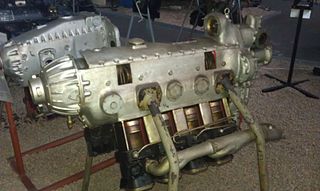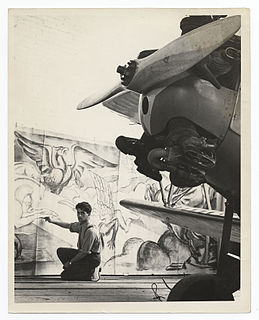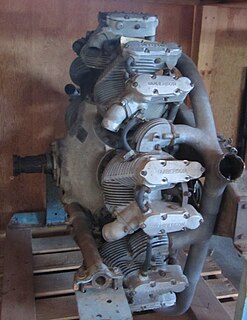
The Piaggio P.XI was an Italian 14-cylinder radial aircraft engine. The P.XI was a licensed derivative of the French Gnome-Rhône Mistral Major 14K produced in Italy. Isotta Fraschini also produced a version of the 14K called the K.14.

The Warner Scarab is an American seven-cylinder radial aircraft engine, that was manufactured by the Warner Aircraft Corporation of Detroit, Michigan in 1928 through to the early 1940s. In military service the engine was designated R-420.

The Franklin O-150 was an American air-cooled aircraft engine of the late 1930s. The engine was of four-cylinder, horizontally-opposed layout and displaced 150 cu in (2 L). The power output was nominally 40 hp (30 kW).

The Potez 4D was a four-cylinder, inverted inline aircraft engine. It was first built shortly before World War II, but did not enter full production until 1949. Like the other D-series engines, the cylinders had a bore of 125 mm (4.9 in) and a stroke of 120 mm (4.7 in). Power for different models was in the 100 kW-190 kW (140 hp-260 hp) range.

The Alfa Romeo 115 was an Italian six-cylinder air-cooled inverted inline engine for aircraft use, mainly for training and light planes, based on the de Havilland Gipsy Six engine. Production totalled approximately 1,600 units. Derivatives of the 115 include the -1, bis, ter and Alfa Romeo 116.

The Alfa Romeo 121 was an eight-cylinder, air-cooled, inverted V engine for aircraft use produced in Italy. It was typically rated at 280 kW (380 hp).

The Hirth HM 508 was an air-cooled, eight-cylinder, 60° cylinder bank angle inverted-V aircraft engine built in Germany in the 1930s. It had a bore and stroke of 105 mm × 115 mm and developed 210 kW (280 hp) at 3,000 rpm.

The Alfa Romeo 110 was an Italian four cylinder air-cooled inverted inline engine for aircraft use, mainly for trainers and light aircraft. The Alfa Romeo 110 was based on the de Havilland Gipsy Major, with approximately 500 units produced. Derivatives of the 110 include the -1, ter and Alfa Romeo 111.

The CNA D, often known as the CNA D.4, was a four-cylinder, air-cooled, horizontally opposed engine built in Italy by Compagnia Nazionale Aeronautica (CNA) between 1940 and 1951 to power light aircraft.

The Kinner K-5 was a popular engine for light general and sport aircraft developed by Winfield B. 'Bert' Kinner. With the boom in civilian aviation after Charles Lindbergh's transatlantic flight the K-5 sold well. The K-5 was a rough running but reliable engine and the K-5 and its derivatives were produced in the thousands, powering many World War II trainer aircraft. The K-5 was followed by the B-5, R-5 and R-55. Military engines were designated R-370

The Kinner B-5 was a popular five cylinder American radial engine for light general and sport aircraft of the 1930s.

The Kinner R-5 is an American five cylinder radial engine for light general and sport aircraft of the 1930s.

Szekely aircraft engines were three-cylinder radial engines built in Holland, Michigan in the 1920s and 30s. They were used to power small aircraft such as the Rearwin Junior, Taylor H-2 and American Eagle Eaglet. Often criticized for reliability issues and design flaws, many were replaced with better engines in their original airframes. Few examples still exist but a museum quality example is on display in the Holland Museum in Holland, Michigan.

The Armstrong Siddeley Cougar was an aero engine developed by Armstrong Siddeley in 1945. The design was a departure from earlier Armstrong Siddeley engines in many ways, it was the company's only nine-cylinder radial design. Although the engine was tested it did not find an aircraft application and was not produced.

The Praga B2 was a low powered aero engine suitable for very light aircraft. It dates from the mid-1930s.
The Potez 4E is a French air-cooled flat-four piston engine of the 1960s. It was unveiled at the 1959 Paris Air Show, entered production in 1960 and is rated at 78 kW (105 hp). It remained in production until 1965 when Potez abandoned production of aero-engines.

The Guiberson A-1020 is a four-stroke diesel radial engine developed for use in aircraft and tanks.

The Walter Sagitta was a Czechoslovakian, air-cooled, inverted V-12 engine that first ran in 1937. With a displacement of 18.4 litres, it produced up to 373 kW at 2,500 rpm.
The Lutetia 4.C.02 was a small V-4 two-stroke engine designed soon after World War II and intended to power light aircraft.
The Kroeber M4 Köller was a 2-stroke air-cooled horizontally-opposed piston engine designed and built by Dr. Kroeber & Sohn G.m.b.H. in Germany in the late 1930s. The M4 proved relatively popular, for powering the ultra-light aircraft and motor-gliders in vogue during the 1920s and 1930s.

















